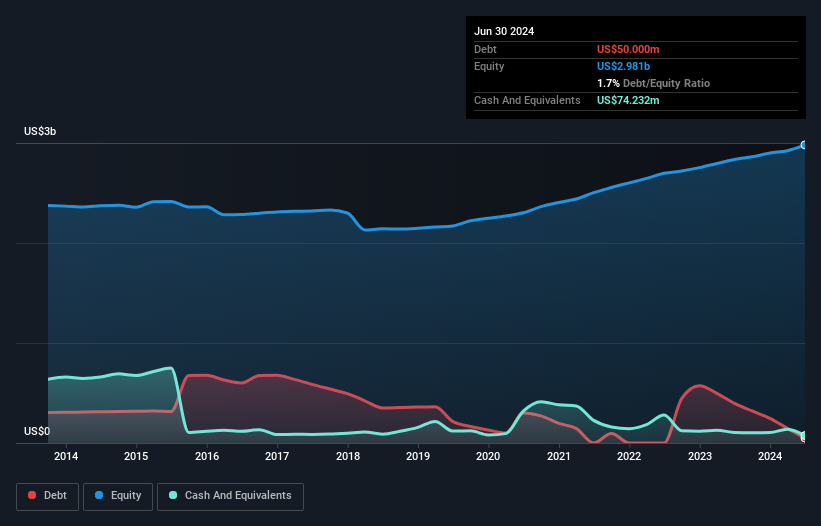- United States
- /
- Metals and Mining
- /
- NasdaqGS:RGLD
Royal Gold (NASDAQ:RGLD) Seems To Use Debt Quite Sensibly

Legendary fund manager Li Lu (who Charlie Munger backed) once said, 'The biggest investment risk is not the volatility of prices, but whether you will suffer a permanent loss of capital.' So it might be obvious that you need to consider debt, when you think about how risky any given stock is, because too much debt can sink a company. We note that Royal Gold, Inc. (NASDAQ:RGLD) does have debt on its balance sheet. But the real question is whether this debt is making the company risky.
Why Does Debt Bring Risk?
Debt is a tool to help businesses grow, but if a business is incapable of paying off its lenders, then it exists at their mercy. If things get really bad, the lenders can take control of the business. While that is not too common, we often do see indebted companies permanently diluting shareholders because lenders force them to raise capital at a distressed price. Having said that, the most common situation is where a company manages its debt reasonably well - and to its own advantage. When we think about a company's use of debt, we first look at cash and debt together.
Check out our latest analysis for Royal Gold
What Is Royal Gold's Net Debt?
As you can see below, Royal Gold had US$50.0m of debt at June 2024, down from US$395.5m a year prior. However, it does have US$74.2m in cash offsetting this, leading to net cash of US$24.2m.

How Healthy Is Royal Gold's Balance Sheet?
We can see from the most recent balance sheet that Royal Gold had liabilities of US$122.4m falling due within a year, and liabilities of US$165.4m due beyond that. Offsetting these obligations, it had cash of US$74.2m as well as receivables valued at US$46.0m due within 12 months. So its liabilities outweigh the sum of its cash and (near-term) receivables by US$167.6m.
This state of affairs indicates that Royal Gold's balance sheet looks quite solid, as its total liabilities are just about equal to its liquid assets. So while it's hard to imagine that the US$8.98b company is struggling for cash, we still think it's worth monitoring its balance sheet. Despite its noteworthy liabilities, Royal Gold boasts net cash, so it's fair to say it does not have a heavy debt load!
And we also note warmly that Royal Gold grew its EBIT by 10% last year, making its debt load easier to handle. The balance sheet is clearly the area to focus on when you are analysing debt. But ultimately the future profitability of the business will decide if Royal Gold can strengthen its balance sheet over time. So if you're focused on the future you can check out this free report showing analyst profit forecasts.
Finally, while the tax-man may adore accounting profits, lenders only accept cold hard cash. While Royal Gold has net cash on its balance sheet, it's still worth taking a look at its ability to convert earnings before interest and tax (EBIT) to free cash flow, to help us understand how quickly it is building (or eroding) that cash balance. Over the last three years, Royal Gold reported free cash flow worth 8.1% of its EBIT, which is really quite low. That limp level of cash conversion undermines its ability to manage and pay down debt.
Summing Up
We could understand if investors are concerned about Royal Gold's liabilities, but we can be reassured by the fact it has has net cash of US$24.2m. On top of that, it increased its EBIT by 10% in the last twelve months. So we are not troubled with Royal Gold's debt use. The balance sheet is clearly the area to focus on when you are analysing debt. However, not all investment risk resides within the balance sheet - far from it. Be aware that Royal Gold is showing 1 warning sign in our investment analysis , you should know about...
If, after all that, you're more interested in a fast growing company with a rock-solid balance sheet, then check out our list of net cash growth stocks without delay.
New: AI Stock Screener & Alerts
Our new AI Stock Screener scans the market every day to uncover opportunities.
• Dividend Powerhouses (3%+ Yield)
• Undervalued Small Caps with Insider Buying
• High growth Tech and AI Companies
Or build your own from over 50 metrics.
Have feedback on this article? Concerned about the content? Get in touch with us directly. Alternatively, email editorial-team (at) simplywallst.com.
This article by Simply Wall St is general in nature. We provide commentary based on historical data and analyst forecasts only using an unbiased methodology and our articles are not intended to be financial advice. It does not constitute a recommendation to buy or sell any stock, and does not take account of your objectives, or your financial situation. We aim to bring you long-term focused analysis driven by fundamental data. Note that our analysis may not factor in the latest price-sensitive company announcements or qualitative material. Simply Wall St has no position in any stocks mentioned.
About NasdaqGS:RGLD
Royal Gold
Acquires and manages precious metal streams, royalties, and related interests.
Flawless balance sheet with solid track record and pays a dividend.
Similar Companies
Market Insights
Community Narratives


